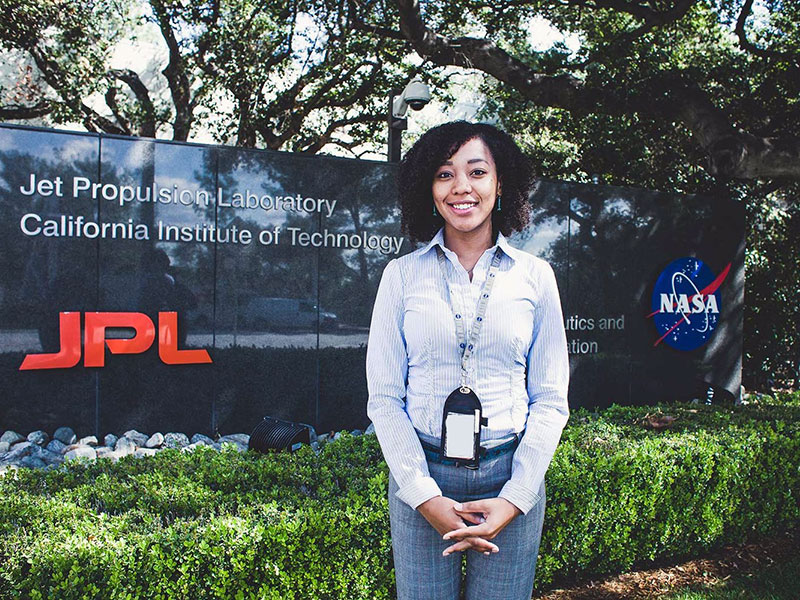One of the human species’ longest-standing questions has always been whether we are alone in the universe. But as scientists search for signs of life somewhere out there, it’s critical that their tools don’t carry with them any signs of life from here.

Moogega Cooper, MS ’08 PhD ’10 (Photo courtesy of NASA/JPL-Caltech)
That’s where Moogega Cooper, mechanical engineering MS ’08 PhD ’10, comes in. Cooper is a planetary protection engineer with NASA’s Jet Propulsion Laboratory. It’s her job to make sure that spacecraft that we send to other celestial bodies don’t carry germs and other microbes from Earth. She was the lead planetary protection specialist for the Mars 2020 mission, overseeing the cleanliness of the designs of the Perseverance rover and Ingenuity helicopter.
“Throughout the process of building the spacecraft, we kept it in a clean room and continuously took swabs to be sure that it hadn’t picked up any contamination,” she explains. “The entire design of Perseverance is intended to ensure that we don’t bring any of Earth to Mars.”
Cooper’s journey to NASA began in fifth grade, when she first saw Carl Sagan’s seminal documentary series Cosmos.
“I actually had poor grades in math and science at the time,” Cooper recalls. “I was a sponge for knowledge, but only for things that I found to be relevant to my interests. The questions asked in Cosmos — what’s gravity, and are we alone in the universe — they made me realize the importance of math and science.”
With Cooper’s passion unlocked, the sky — or perhaps more accurately the stars — were the limit. She finished high school at 16 and graduate summa cum laude from Howard University with a major in physics and a minor in space, earth, and atmospheric sciences. She then came to Drexel to study mechanical engineering and mechanics.
“I chose mechanical engineering because it has so much hands-on practicality,” she says. “It feeds that part of me that wants to have direct interaction with what I’m studying.”
While at Drexel, Cooper worked with Alexander Fridman, PhD, John A. Nyheim Chair Professor and Director of the C. J. Nyheim Plasma Institute on using plasmas to disinfect spacecraft materials. The technology hasn’t been used in any of her professional projects, but Cooper sees promise in the method.
“One possible application would be using plasma to sterilize sample holders when they return to Earth,” she says. “We know that the technology can kill off microbes in life as we know it, so now we need to find out if it can do the same for life as we don’t know it.”
Why be so diligent about decontaminating something that’s being sent through the cold vacuum of space, the heat of a planetary entry, and the harsh, carbon dioxide-rich Martian atmosphere that we already know humans can’t survive? Cooper points out that other contaminants can survive these conditions.
“First of all, it’s good interplanetary manners,” she says. “You don’t want to track mud onto your neighbor’s carpet, and you don’t want to bring microbes to another planet. Besides, as a scientist looking for biosignatures of something that is living or used to live, you don’t want to confuse the search by bringing your own lifeforms along for the ride.”
More pressing, though, is protecting the solar system.
“I chose mechanical engineering because it has so much hands-on practicality. It feeds that part of me that wants to have direct interaction with what I’m studying.”
Moogega Cooper
“We see so many examples of how an ecosystem can be impacted by a microbe that is introduced in to a new environment,” Cooper says. “You can see good impacts like when we consume probiotics, but it isn’t always positive. We’ve seen examples on earth where whole ecosystems can completely change. We can’t allow something like that to happen on another planet.”
With Perseverance safely and sanitarily on Mars, Cooper is shifting her focus. She is now the lead planetary protection engineer for a mission to land a craft on the surface of Europa, one of Jupiter’s moons. Europa is known to have a thick sheet of ice — experts suggest it may be about 20 kilometers thick — floating on an ocean that’s believed to be more than 100 kilometers deep in some places. Where there’s water, there’s a good possibility for life, and Cooper is excited to be sure that the lander is considerate of that potential life.
“The requirements are very different from the Mars rover,” she explains. “Europa’s environment is exposed to a lot of gamma and electron radiation. We can build protective shields to keep the spacecraft safe, but those shields can also protect Earth microbes. So we have to figure out what can survive that environment and make sure that the craft is free from those contaminants when we launch.”
With what time she has to spare when she’s not protecting the galaxy from Earth germs, Cooper tries to be for young students what Carl Sagan and Cosmos were for her: inspiration. She is involved in several science outreach programs and has appeared on a number of TV shows, including Discovery’s How the Universe Works and Netflix’s Bill Nye Saves the World.
“My mantra for life is anyone can understand any topic if you make it accessible for them,” she says. “The great thing about NASA is that most of the people I work with are excited to share their expertise and want you to understand the concepts they’re working on. I’m happy to be part of that tradition.”